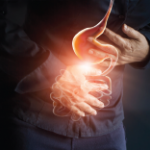For gastric involvement, a chief adjustment is to eat the same number of calories, but over five or six meals instead of three. And, for the small bowel, the idea is to avoid gas-producing foods, such as lactose, fructose and wheat, and high-sugar foods.
The somatostatin analogue, octreotide, and the acetylcholinesterase inhibitor, pyridostigmine, are two additional prokinetic options for the small bowel.
Antibiotics are also an option but, Dr. Clarke said, “there are no guidelines as to which ones you use, how long to use them, which cycle to do.” His approach is to try ciprofloxacine, metronidazole or rifaximin for two weeks, then decide on how frequently to rotate them, and whether to incorporate an antibiotic-free period, based on the clinical response.
For the colon, treatments include osmotic laxatives; lubiprostone to stimulate chloride secretion, although it comes with “pretty significant” nausea effects; and linaclotide to stimulate fluid secretion.
Referral & Tests
Dr. Clarke said a patient should be referred to a gastroenterologist if a clinical presentation is unusual, if a patient isn’t responding to typical treatment, if there is a concern about complications or if there is a need for a procedure.
There is some belief that an endoscopy should be done relatively early in these patients, in part because of a heightened risk of Barrett’s esophagus, which in most patients is about a 12% risk. Dr. Clarke noted, though, that such a risk is “not terribly different from all comers.” There is also a high prevalence of strictures, reflux esophagitis and a concern that symptoms might not well represent the findings from an endoscopy.
A four-stage process of GI involvement [in scleroderma] has been proposed, with an early vascular lesion followed by neural dysfunction, & then smooth muscle atrophy followed by smooth muscle fibrosis. … Dysmotility is the main manifestation, with poor propulsion of food through the gut.
There has also been a case made for early manometry, because of an association between esophageal dysmotility and lung disease, although Dr. Clarke said this supposed benefit is controversial as well.
When medical treatment fails, physicians can turn to barium studies, endoscopy, manometry and formal reflux testing.
“We have a number of tools that we can use to better define what’s going on with both movement and reflux, and then hopefully take that information and try and customize what patients are on at that point,” Dr. Clarke said.
Questions Remain
Several important questions in the area of dysmotility and autoimmune disorders beg to be answered, he said—including whether GI involvement progresses with time, whether there are clinically distinct subsets, whether early treatments prevent GI complications, how the microbiome is involved and, most importantly, what the underlying cause is.


